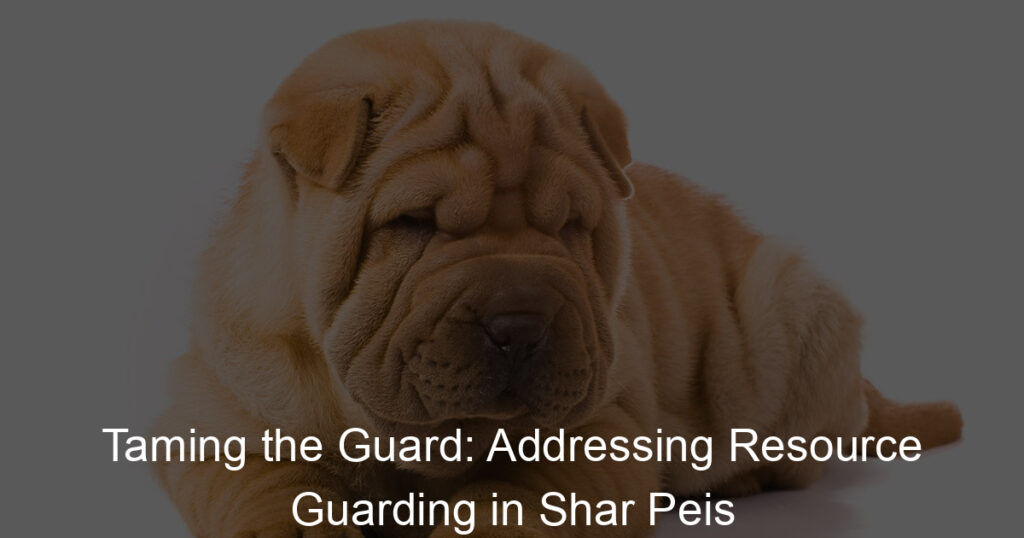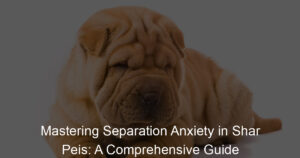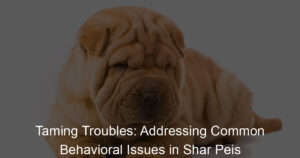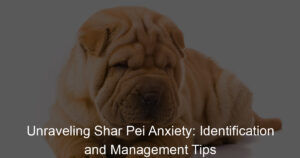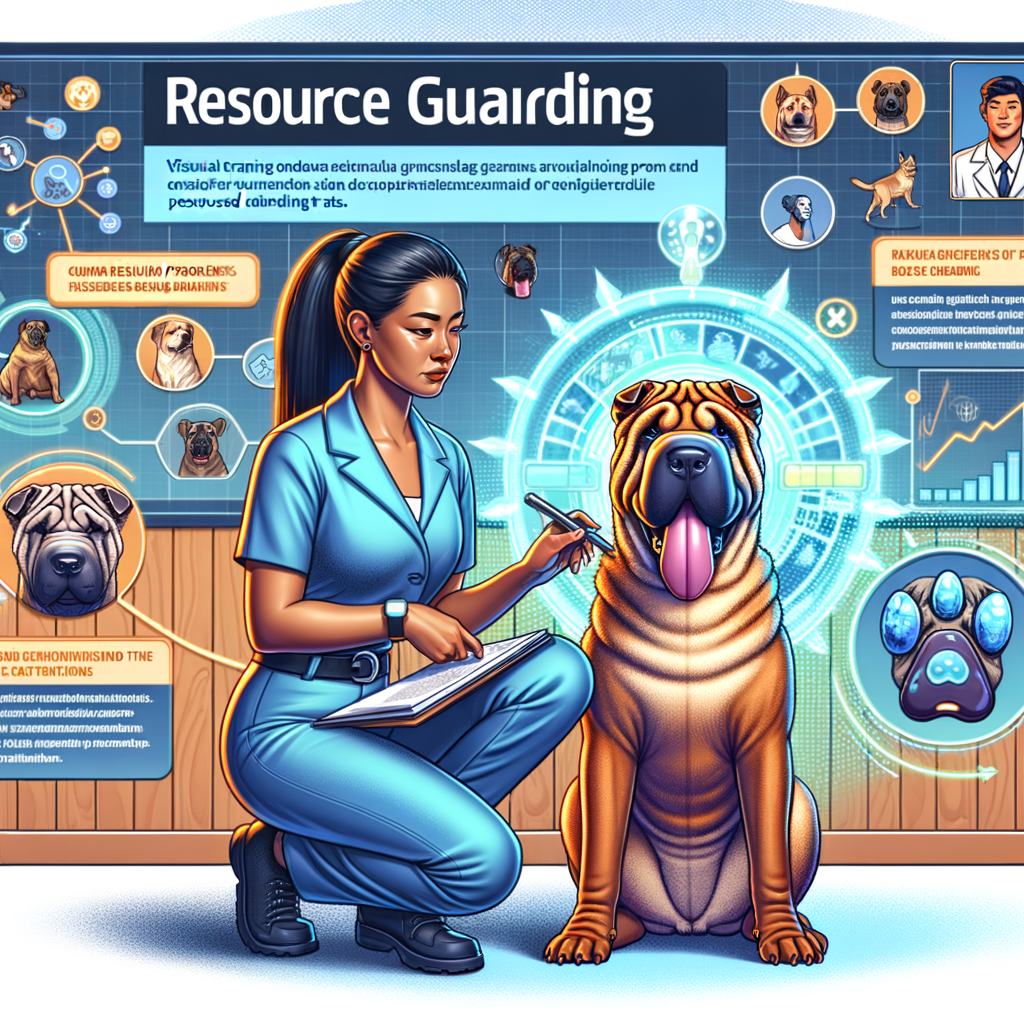
Introduction to Shar Pei Behavior
The Shar Pei is a unique breed with a distinct personality and behavior. Understanding these behaviors is crucial for any potential or current Shar Pei owner. In this section, we will delve into the breed’s characteristics, common behavior problems, and signs of aggression.
- Understanding the breed
- Common Shar Pei behavior problems
- Recognizing Shar Pei aggression
The Shar Pei is a breed that originated in China and is known for its deep wrinkles and blue-black tongue. They are intelligent, independent, and sometimes aloof. Shar Peis are known to be loyal to their families and can be reserved with strangers. They are often described as having a “stoic” demeanor, which can sometimes be misunderstood as aggression.
Like any breed, Shar Peis can exhibit certain behavior problems. These can include stubbornness, resource guarding, and separation anxiety. Stubbornness often stems from their independent nature. Resource guarding, where a dog protects its food, toys, or space, can be a significant issue in Shar Peis. Separation anxiety can occur if they are left alone for extended periods, leading to destructive behavior.
While Shar Peis are not inherently aggressive, certain behaviors may indicate potential aggression. These can include growling, snapping, or a stiff body posture. It’s important to note that these behaviors can also be signs of fear or anxiety. Therefore, understanding the context and triggers is crucial in managing and addressing these behaviors.
In the following sections, we will delve deeper into one of the most common issues in Shar Peis – resource guarding. We will discuss how to recognize it, address it, and share some case studies of successful interventions. Stay tuned to learn more about managing your Shar Pei’s behavior effectively.
Recognizing Resource Guarding in Dogs
Resource guarding is a behavior that is commonly seen in dogs, including Shar Peis. It’s important for dog owners to recognize and understand this behavior to ensure a safe and harmonious environment. In this section, we will discuss what resource guarding is, the signs of resource guarding in dogs, and specific signs of resource guarding in Shar Peis.
- Definition of Resource Guarding
Resource guarding refers to a dog’s behavior where it becomes defensive and shows aggression when it feels that its resources are threatened. These resources can include food, toys, a favorite spot, or even a person. It’s a natural instinct for dogs to protect their resources, but it can become a problem when it leads to aggressive behavior.
- Signs of Resource Guarding in Dogs
There are several signs that a dog may be resource guarding. These can include growling, snarling, or snapping when someone approaches their resource. The dog may also stand over the resource to protect it, or they may quickly eat or hide the resource when someone comes near. It’s important to note that not all dogs will show these signs, and some may only show them in certain situations.
- Specific Signs of Resource Guarding in Shar Peis
Shar Peis, like other breeds, can exhibit resource guarding. However, there are some specific signs that Shar Pei owners should be aware of. These can include a stiffening of the body when someone approaches their resource, a hard stare, or a sudden change in behavior. Shar Peis may also show signs of resource guarding by becoming more possessive of their owners or becoming aggressive when other dogs or people approach their owners.
Recognizing resource guarding in dogs, especially in Shar Peis, is the first step towards addressing this behavior. In the next section, we will discuss how to address resource guarding in Shar Peis.
Addressing Resource Guarding in Shar Peis
Resource guarding is a common behavior in Shar Peis, but it can be managed with the right training techniques. Here, we will discuss three key methods to address this issue.
Shar Pei Training Techniques
Training your Shar Pei to overcome resource guarding involves a series of steps. These steps are designed to build trust, teach commands, and encourage positive behavior.
- Establishing trust and respect
- Teaching the ‘leave it’ command
- Practicing ‘trade up’ exercises
Trust and respect form the foundation of any successful training. Spend quality time with your Shar Pei, engage in play, and provide consistent care. This will help your dog see you as a leader, making them more likely to follow your commands.
The ‘leave it’ command is a crucial tool for managing resource guarding. Start by holding a treat in your closed hand. When your Shar Pei stops trying to get the treat and pulls away, say ‘leave it’ and give them the treat. Repeat this exercise until your dog associates the command with the action.
‘Trade up’ exercises involve offering your Shar Pei a higher value item in exchange for what they’re guarding. For example, if your dog is guarding a toy, offer a tasty treat. When they drop the toy to take the treat, praise them. This teaches your dog that giving up what they’re guarding leads to a better reward.
Remember, patience and consistency are key when training your Shar Pei. It may take time, but with persistence, you can help your dog overcome resource guarding.
Professional Help for Canine Resource Guarding
While training techniques can be effective in addressing resource guarding in Shar Peis, there are instances when professional help may be required. This section will guide you on when to seek professional help, the types of professionals who can assist, and the expected outcomes with professional intervention.
- When to Seek Professional Help
- Types of Professionals Who Can Help
- Expected Outcomes with Professional Intervention
If your Shar Pei’s resource guarding behavior is severe or if your attempts at training have not produced the desired results, it may be time to seek professional help. This is particularly important if the dog’s behavior poses a risk to the safety of people or other pets in the household.
There are several types of professionals who can assist with resource guarding in dogs. Certified dog trainers, animal behaviorists, and veterinary behaviorists are all equipped to handle this issue. These professionals have the knowledge and experience to design a behavior modification plan tailored to your dog’s specific needs.
With the help of a professional, you can expect significant improvements in your dog’s behavior. The professional will work with you and your dog to gradually reduce the guarding behavior. This process may take time and patience, but the end result is a safer and more peaceful home environment. Remember, the goal is not to eliminate your dog’s natural instinct to guard resources, but to manage it in a way that is safe and acceptable.
In conclusion, professional help can be a valuable resource in addressing resource guarding in Shar Peis. These professionals can provide the expertise and guidance necessary to effectively manage this behavior and improve the quality of life for both you and your dog.
Case Studies: Resource Guarding Solutions
Let’s delve into some real-life examples to better understand how resource guarding can be effectively managed in Shar Peis. These case studies will illustrate the practical application of various techniques and strategies.
- Case Study 1: Overcoming Food Guarding with Positive Reinforcement
Meet Bella, a 2-year-old Shar Pei who had a severe case of food guarding. Whenever anyone approached her while she was eating, Bella would growl and snap. Her owners decided to try positive reinforcement to address this issue.
They began by standing at a distance where Bella felt comfortable while eating. Then, they slowly closed the gap over several weeks, rewarding Bella with treats and praise whenever she remained calm. Over time, Bella began to associate people approaching her food bowl with positive experiences, effectively reducing her food guarding behavior.
- Case Study 2: Addressing Toy Guarding through Desensitization
Next, we have Max, a Shar Pei who was extremely possessive of his toys. His owners used a technique called desensitization to help Max overcome his toy guarding tendencies.
They started by presenting a less favored toy to Max and then gradually introduced his favorite toys into the mix. If Max showed any signs of aggression, they would remove the toy and start again with a less favored one. This process was repeated until Max could comfortably share all his toys without showing any signs of guarding.
- Case Study 3: Successful Management of Space Guarding with Professional Help
Lastly, let’s look at the case of Daisy, a Shar Pei who was very protective of her space. Daisy’s owners sought professional help to manage her space guarding behavior.
A professional dog trainer worked with Daisy, using a combination of positive reinforcement and desensitization techniques. The trainer also educated Daisy’s owners on how to handle and prevent future incidents of space guarding. With consistent training and patience, Daisy’s space guarding behavior significantly improved.
These case studies demonstrate that with the right approach and a lot of patience, resource guarding in Shar Peis can be effectively managed. Remember, every dog is unique, and what works for one might not work for another. It’s important to understand your dog’s specific needs and consult with a professional if needed.
Key Takeaways: Addressing Resource Guarding in Shar Peis
-
Understanding the Behavior
Resource guarding is a natural instinct in many dogs, including Shar Peis. It involves the dog protecting its food, toys, or other resources from others. This behavior can become problematic when it leads to aggression. It’s important to understand that your Shar Pei isn’t being ‘bad’ – they’re simply acting on their instincts. However, it’s a behavior that needs to be addressed for the safety and harmony of your household.
-
Implementing Training Techniques
Training is key in addressing resource guarding. Start by teaching your Shar Pei basic commands like ‘leave it’ and ‘drop it’. Gradually introduce situations where your dog has access to resources, and use these commands to discourage guarding behavior. Remember, patience and consistency are crucial. Reward your dog for good behavior to reinforce positive actions.
-
Knowing When to Seek Professional Help
If your Shar Pei’s resource guarding behavior escalates, or if they become aggressive, it’s time to seek professional help. A professional dog trainer or a behaviorist can provide targeted strategies and techniques to address the issue. They can also help ensure the safety of all members of your household during the training process.
-
Learning from Case Studies
Case studies can provide valuable insights into addressing resource guarding in Shar Peis. For example, a case study of a Shar Pei named Max showed how consistent training and positive reinforcement helped reduce his resource guarding behavior. Max’s owner worked with a professional trainer and implemented a training plan that gradually desensitized Max to others being near his resources. Over time, Max’s resource guarding behavior significantly decreased.
Conclusion: Taming the Guard in Your Shar Pei
As we draw this discussion to a close, it’s important to remember that resource guarding in Shar Peis is a behavior that can be managed with the right knowledge and techniques. Let’s take a moment to recap and share some final thoughts on this topic.
- Recap of resource guarding in Shar Peis:
- Final thoughts on addressing this behavior:
Resource guarding is a natural behavior in Shar Peis, often triggered by fear of losing valuable resources like food, toys, or territory. It’s a behavior that can manifest in various ways, such as growling, snapping, or even biting. However, with understanding, patience, and the right training techniques, it’s possible to manage this behavior effectively.
Addressing resource guarding in Shar Peis is not a one-size-fits-all approach. It requires a tailored strategy that considers the unique temperament and needs of your dog. Positive reinforcement, gradual desensitization, and counter-conditioning are some of the effective techniques that can be used. Remember, it’s crucial to consult with a professional dog trainer or behaviorist if you’re struggling with this issue.
In conclusion, taming the guard in your Shar Pei is a journey that requires patience, understanding, and consistency. It’s a journey that can strengthen the bond between you and your furry friend, ensuring a harmonious and happy coexistence. Remember, every dog deserves to feel safe and secure in their environment, and it’s our responsibility as pet owners to provide that for them.

